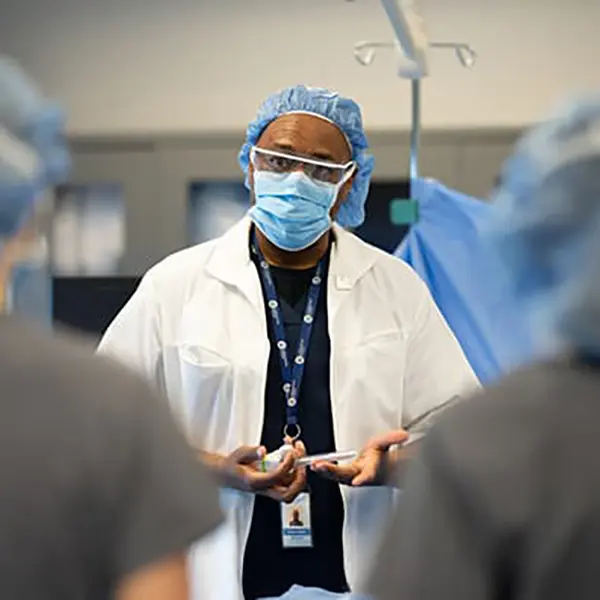Surgical Technology

Request Information
All fields using an asterik (*) are required.
Request Information
*Required Field

Program Details
What Will I learn
Upon completion of the Surgical Technology program, graduates will be able to:
Cognitive (Knowledge)
- Explain the eligibility criteria required to successfully complete the National Certification Exam for Surgical Technologists.
- Apply the knowledge of human anatomy and physiology, microbiology, and pharmacology as it relates to a variety of surgical procedures.
Psychomotor (Skills)
- Practice the correct solutions in applying aseptic techniques in a variety of clinical environments.
- Apply safe practice techniques with the handling of instruments, surgical supplies, and direct patient care in the surgical and sterile processing environment.
- Demonstrate the consistent application of surgical consciousness in the clinical setting.
Affective (Behavior)
- Explain the value of accountability, competence, and character in a surgical technologist in the healthcare environment.
- Demonstrate the importance of critical thinking and communication in the surgical setting as a member of the healthcare team.
- Connect the impact of social competence, professionalism, and ethical values to display respect and advocacy for the surgical patient, healthcare team, and the college as expected from entry-level healthcare professionals.
Military Policy
Cost & Financial Aid
Your education is an investment in your future, and Carrington College is here to help. We offer a variety of financial aid options, including federal, state, and private programs, as well as student loans, grants, and scholarships are available for those who qualify. Each program has different requirements and application instructions. Our team is here to guide you through the options and application process.
Academic Cost
For complete details on current tuition costs, please refer to the Academic Catalog.
Location Availability
Carrington College’s Surgical Technology program is available at locations in California and Arizona.. To learn more about each location, explore their campus pages.
Accreditation & Approvals
Carrington College is accredited by the Accrediting Commission for Community and Junior Colleges, 428 J Street, Suite 400, Sacramento, CA 95814; 415 506 0234 an institutional accrediting body recognized by the Council for Higher Education Accreditation and the U.S. Department of Education. Additional information about accreditation, including the filing of complaints against member institutions, can be found at accjc.org.
For comprehensive information on Carrington College’s accreditation and approvals, visit carrington.edu/accreditation-and-approvals/.
The Surgical Technology program at the Bakersfield, Fresno, Phoenix, Rancho Cordova, San Jose and Temecula campuses are accredited by the: Commission on Accreditation of Allied Health Education Programs (CAAHEP) upon the recommendation of the Accreditation Review Council on Education in Surgical Technology and Surgical Assisting, CAAHEP, 9355 – 113th Street N, #7709, Seminole, FL 33775, 727 210 2350, www.caahep.org.”
Course Catalog
Program Specific Disclosures
Retention Rate
Based on the most recent annual report submitted to the Accreditation Review Council on Education in Surgical Technology and Surgical Assisting (ARC/STSA) and the Commission on Accreditation of Allied Health Education Programs (CAAHEP) for the reporting window of August 2023 through July 2024:
- San Jose: 53%
- PHX: 54%
Continuing Education For Graduates
Student Outcomes
REAL WORLD SKILLS
START YOUR PATH
FLEXIBLE LEARNING OPTIONS
AFFORDABLE TUITION

Career Opportunities
Surgical technologists play a vital role on a healthcare team. Keeping surgical equipment and operators sterile is a very important job. Surgical technologists help maintain a sterile environment in hopes of reducing postoperative infections in patients.
According to the BLS, some typical surgical technologist job duties may include:1
- Preparing operating rooms for surgery
- Sterilizing equipment and making sure there are adequate supplies for surgery
- Readying patients for surgery, such as by washing and disinfecting incision sites
- Helping surgeons during surgery by passing them instruments and other sterile supplies
- Counting supplies, such as surgical instruments, to ensure that no foreign objects are retained in patients
- Maintaining a sterile environment to prevent patient infection
What Will I Learn?
Basic Surgical Procedures
Surgical Case Management
Advanced Surgical Procedures
Introduction to Surgical Technology
Check out our guide on becoming a Surgical Technologist.
The operating room hums with tension. A surgeon is painstakingly operating on a patient. The room is full of medical personnel who all serve important purposes. And you’re there, in the middle of the action. If that sounds like an exciting and fulfilling career, then you may be looking to become a surgical technologist. Surgical technologists serve an important role in hospitals and surgical centers, working under the supervision of doctors, nurses, or other surgical personnel to make sure the operating room is ideal for surgery.
Discover What It’s Like to Train to Become a Surgical Technologist at Carrington College
Surgical Technology FAQ
-
Different schools have different requirements for their surgical tech programs—some certificate programs claim they can be earned in a year. At Carrington College, we offer a comprehensive Associate of Science in Surgical Technology program designed to help you build the foundational skills you need to experience success and growth throughout your career. Our program can be completed in as few as 15 months.
-
Aspiring surgical techs will need to complete specialized training before pursuing a role in the industry. Coursework in the area will cover anatomy, physiology, medical terminology, and other essentials of this type of patient care.At Carrington College, our Surgical Technology program offers the insights, skills, and associate degree credential needed to perform the duties of a surgical technologist.
-
A surgical technician, also known as an operating room technician and surgical technologist, assists the medical team within an operating theater. Before the operation even starts, they are sterilizing equipment, assembling instruments, and helping prepare the patient for surgery. They maintain the sterile operating environment during surgery. After the operation, they count up instruments and safely dispose of used materials, among other duties.
-
Essentially, there is no difference in the operating theater. Whether known as a surgical technician or technologist (or operating room technician), these medical professionals are essential to every surgical team. They help ensure surgical success by assembling needed surgical equipment, maintaining the sterility of an operating environment, and disposing of used materials.